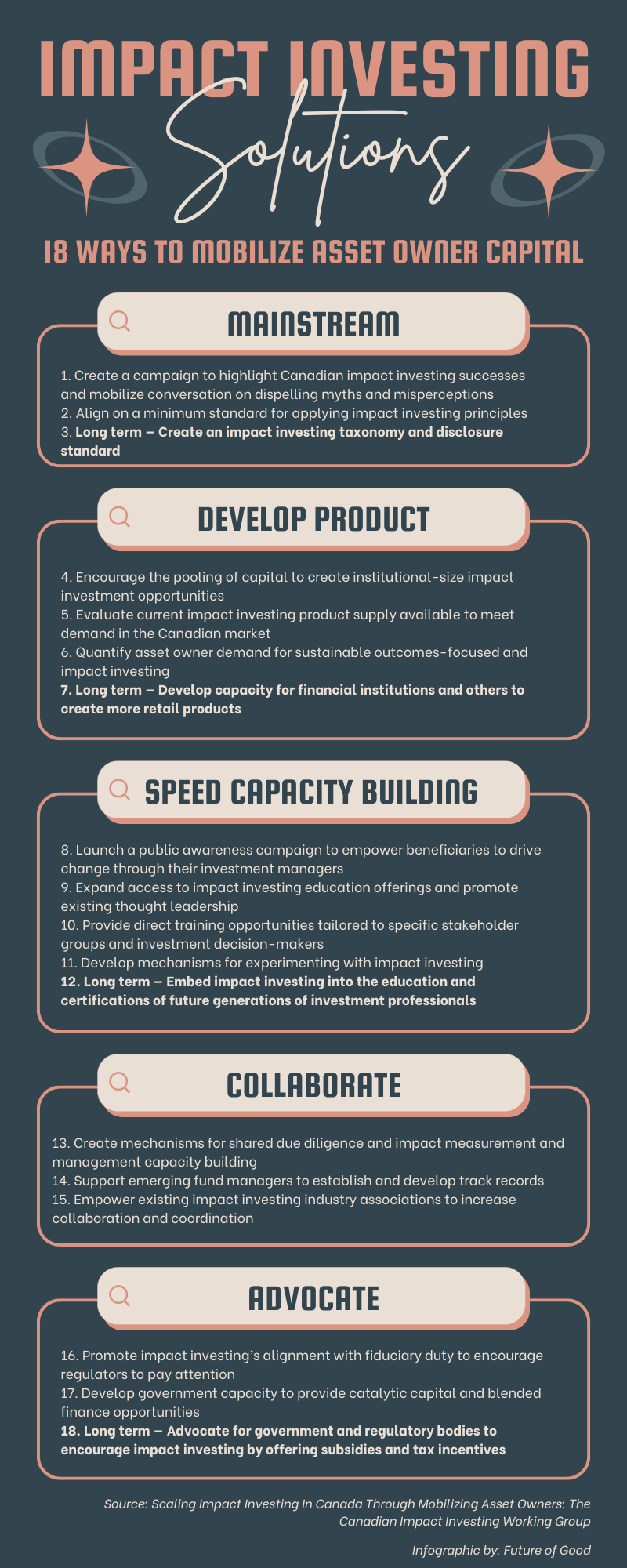Solutions to triple impact investing in Canada by 2030: new report
Why It Matters
The Canadian impact investing industry has grown by 56 per cent since 2015 but still has trouble scaling up, leaving dollars on the table for non-profits.

A report released Monday by a group of financial social impact experts says Canadian financial institutions and investment firms need to be bolder and consider their investments’ long-term financial and planetary gains.
“We stand at a critical juncture in our history, where the decisions we make today will shape the world of tomorrow,” said Stéphan Morency, executive vice president of the Canadian Impact Investing Working Group (CIIWG).
Morency said impact investing—investments that generate positive social and environmental outcomes along with financial returns—is growing in Canada but should grow more quickly.
The report, called Scaling Impact Investing in Canada Through Mobilizing Asset Owners: 18 Solutions to Triple Impact Investing in Canada by 2030, says impact investing in Canada has grown by 56 per cent since 2015, but there is nearly unlimited opportunity.
The report provides five broad key findings about why things are changing and how to help them change faster.
1. Prominent asset owners are getting involved in impact investing because their boards, top executives, and company culture are pushing for it.
Just like any new market, the growth of impact investing depends on those who jump in first and show others how it’s done, says the report.
Asset owners who’ve already hopped on the impact investing train say top-level execs and boards are leading the charge. They believe in the idea of impact investing or have seen evidence that it can bring both positive outcomes and financial gains that align with their fiduciary duties.
There is a hunger for innovation baked into the company culture, which encourages everyone to explore how to get involved in impact investing. The first impact asset managers are responding by creating various investment options across different asset classes to meet the growing demand.
2. Beneficiaries are urging asset owners to rethink their investment strategies and use their money for positive impact.
Some asset owners are starting to explore or adopt impact investing strategies because their beneficiaries and other key stakeholders are pushing for it, says the report.
The report uses Canadian university endowments as an example, as the funds have felt the heat from stakeholders to steer clear of industries that harm and instead put their money where it can benefit both people and the planet.
Foundations and family offices, especially as they navigate a massive intergenerational wealth transfer worth trillions of dollars, are also keen on making sure their investments contribute to a better world, the report continues.
Canadian pension fund managers are also feeling pressured. Their plan members, the companies sponsoring the plans they manage, and potential employees are clamouring for investments that align with their values and make a positive impact.
3. Impact investing is seen as part of the fiduciary duty of asset owners and is increasingly viewed as a way to tackle big, systemic problems.
Many asset owners argue that impact investing aligns with their fiduciary duty, says the report. For example, foundations want to make sure their investments aren’t adding to the issues they’re trying to solve through their philanthropy.
As well, some government funds have a mandate to not only preserve capital but also to help address the challenges that governments are often tasked with solving.
Pension funds and insurance companies, focusing on long-term investments, are in a prime position to embrace impact investing as a strategy, especially if it can also tackle systemic issues like climate change, inequality, and political instability. By investing in solutions that address these challenges, they can potentially reduce long-term risks, said the report.
Ideally, impact investments will benefit the financial bottom line and reassure pension beneficiaries that they’re retiring into a more sustainable and equitable world.
4. If the industry can agree on the core principles of impact investing, more asset owners might hop on board.
Almost all investors acknowledge there’s some confusion about what impact investing really means, said the report.
However, the definitions used by 13 different Canadian impact investing organizations found that most say that intentionality and measurement are key principles.
If the market as a whole grasps and adheres to these principles, more asset owners will participate, said the report.
The misconception that impact investing means sacrificing financial returns is another misconception, said the report authors. That’s not necessarily the case, but some asset owners shy away because they think it goes against their duty to make solid financial gains for their beneficiaries.
As impact investing becomes more widespread, the argument for its unique contribution might become less important.
5. Unlocking Canadian impact investing assets under management (AUM) involves addressing concerns about labels and showing how impact creates long-term value.
Some of Canada’s biggest asset owners have intentionally put money into companies, funds, and products that aim to make a measurable, positive social and environmental impact, said the report. However, they usually slot these investments into their responsible or sustainable investing plans or under specific themes.
They’re hesitant to call them “impact investments” because they worry about being accused of “impact washing” or seen as sacrificing financial returns, said the report.
While some asset owners think labelling their investments as impact could be more trouble than it’s worth, other impact investors see measuring and managing impact as a way to ensure they create value over the long haul.
The report said those asset owners are starting to use impact as a lens to examine their existing investments and see how they’re doing on social and environmental fronts. As this approach gains traction, it could be a way for more Canadians to dip their toes into impact investing.
18 things
CIIWG’s report, funded by Fondaction and researched and written by Quinn+Partners, said they have 18 actions to help academics, impact investors, financial institutions, government, industry and professional associations, advisors, and consultants come together to move impact investing forward.
The group’s goal? To triple impact investing in Canada by 2030.

While that is an ambitious goal, it’s not impossible, said Morency.
“Our group is calling on its peers for more audacity and ambitious actions in the pursuit of a financial system that addresses the people’s needs while respecting the limits of the planet,” said Morency.
“It is our duty.”

